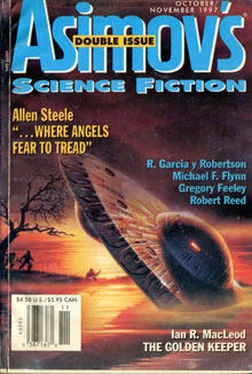Collected Ogoense
by Rebecca Ore

Illustration by Shirley Chan
In the basement of the research institute, Sarafina kept the rainforest killifish that obsessed her. Oh-go-en-say, as the nomenclature police would have it spoken, is an Aphyosemion species or group of almost identical species from the Ogo drainage of Gabon and Congo. African Rift Lake cichlids evolved the fastest of Earth’s fishes, but killifishes in their small disrupted waters were close. Other Aphyosemions presented more interesting material, but Sarafina loved the ogoense.
For five years, Sarafina took her vacation in Africa and smuggled out fish. Customs never bothered her, as she looked small and older than she was, a prematurely middle-aged woman in her early thirties, not yet old enough to have to smuggle to aid desperate finances, not young enough to smuggle for adventure.
Sarafina kept all her collected ogoense in two air-conditioned closets off her main work space. One was set to vary between 68 degrees at night to 72 during the day. The other closet had night and day temperatures 5 degrees higher. Sarafina wondered how domestication would affect ogoense, if more variants would develop in her aquariums.
In the main lab room, Sarafina charted a segment from the fourth chromosome for the Human Genome Project. When the Human Genome Project began, top research scientists had sequenced the DNA themselves. Then, rather than be caught in DNA coils forever, they gave the work over to post-docs, then to senior graduate students and researchers. Sarafina ruefully told herself that her work could have been a small application in military computer code, sequence, and deliver, for all that she ever knew about the final results of it.
I wouldn’t look so middle-aged if I had finished my Ph.D. and had my own lab, she thought as she boarded the plane to Libreville.
Another budget trip to Africa. After landing, Sarafina took a taxi to the bush and found children to catch fish for her. Then she packed through AIDS- and Ebola-stricken villages to a branch of the Ogo that had uncollected stretches in it.
Back at the airport, bagged fish in her luggage among the underwear, her bra underwires replaced by plastic tubing stuffed with fish eggs and siliconed closed at the ends, Sarafina saw the airplane coming to take her away, and sighed in relief.
But the man who’d been checking passports and letting Europeans and Americans go without inspecting their luggage looked down at Sarafina’s passport, frowned, then checked the number against a laminated sheet. Then he said, “Let me see what’s in your luggage.”
When coming through US Customs with Aphyosemion ogoense, Sarafina pronounced all the vowels and didn’t mention the various subspecies to the US Customs agent scrolling through his CITES list of protected animals. Here, she just tensed.
Ogoenese males are blue or yellow with broken red stripes, nose to tail. Some subspecies have red bars in the back third of the body. The females are dotted red on an olive body, sometimes with a pale blue shine. Some subspecies had died for new housing developments before anyone even knew they might be in danger.
The man opened Sarafina’s suitcases, checking the camera number against her US customs certificate, going through her purse first, then through the small over-night case. A woman came up to help him, and wrestled Sarafina’s second suitcase up to the counter and opened it.
Fanatic aquarists had their own species of customs horror stories. Sarafina stood in her sweat and remembered the two Germans she’d met at an International Betta Conference. The year after she’d met them, they’d died in Brunei trying to cross into Borneo with Betta macrostoma, an elongated and less brightly colored kin of the Siamese fighting fish. Betta macrostoma had its charms, the orange-and-black-striped tail, the duller orange body, and its more elaborate sex life with its nuptial embrace, the female catching the falling eggs and spitting them at the male, who then brooded them in his large mouth. A handsome animal, Sarafina thought, but she wouldn’t have chosen to die at the hands of the Royal Brunei Pohce for it.
Still, she empathized with the passion. She’d heard Betta fanciers talk about the route through Borneo into Brunei, then to Kampong Labi, to an elevated lake. The fish, never common, hid in tangles of fallen trees.
“Can you just let me go?” Sarafina asked, tensing. “The plane is ready to take off.”
“We let you come in so we could catch you,” the woman customs agent said, her hands moving aside the clothes covering the fish bags. “You’re stealing from Gabon.”
“No!”
Sarafina suddenly attacked the woman with fingernails and teeth and flailing fists. After a shout, and a moment of confused struggle, the two customs agents wrestled her to the concourse floor, then twisted her arms until she almost fainted. “What are you going to do to me?” she asked, when she could get her breath back.
“What do you think we’re going to do to you?” the woman customs agent asked. Blood streamed from the marks Sarafina’s nails had left on her face as she pulled the plastic bags full of fish out of the suitcase. “What are these things in your luggage? We were told to search for the plastic bags of a smuggler.”
“Fish,” Sarafina answered. The customs agents laughed. Sarafina wondered how many illegal fish collectors they caught in a month. She’d been a fool, she realized; fighting wouldn’t help the fish. She stopped struggling. The customs agents pulled all the bags of fish out of Sarafina’s clothes, but didn’t seem to notice the airline tubing that Sarafina used to replace her bras’ underwires. The tubes were full of ogoense eggs, siliconed at each pair of ends. As Sarafina looked away from her bras, two guards came up and politely took her to the lieutenant.
As she walked back with her guards, Sarafina thought again about the German Betta smugglers. Odd to think of Gregor and Hans dead for patriarchal fish. (When she’d read the brooding classification systems as an eight-year-old, Sarafina had wondered, Did this make the human family system matriarchal because the females tended the young?). Had someone informed on them? Had the fish been in plastic bags taped to their bodies? Had the fish been shot, too?
Sarafina had been a graduate student until her funding was eliminated, when society decided it was cruel to train more Ph.D.’s than could get jobs in their fields. Year after year, she charted chromosomal segments. She knew she wasn’t the only ex-graduate student working out bits of human-building information. Somewhere in the National Institute of Science, other workers compiled the results, eyes on split screens, fingers calling up the files that clerks loaded on their hard drives at night.
Now she was busted in Africa.
What benefit does this research have to the private sector? the congressmen reviewing grants had asked. Sarafina’s work didn’t qualify. No one wanted an Aphyosemion ogoense genome project. But if the human genome was mastered, the private sector could build better people. Rapid evolution in other vertebrates was a political liability when Fundamentalists held the swing votes.
What would the Africans think? The guards brought her through cinderblock halls behind the main concourse to an office door leaking cool air along the bottom. The guards knocked. A voice said, “Awntrey,” no, entrez, French. Sarafina felt her bush French evaporate.
Читать дальше













